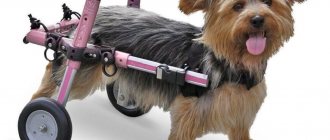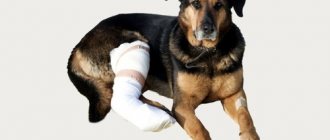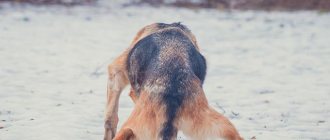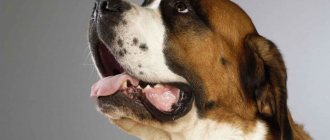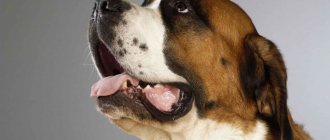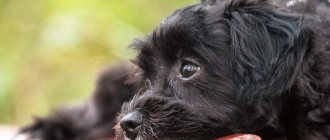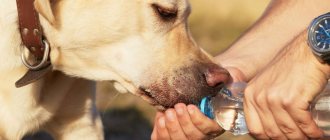Sometimes owners of pet dogs face a serious problem - the dog’s paws are lost. This often occurs due to an accident or other accident, but some breeds have a genetic tendency to develop hind limb paralysis.
Most often, misfortune happens suddenly and greatly shocks the owners. Therefore, they must know what to do if the dog’s hind legs fail.
Why the dog began to walk poorly with its hind legs: causes and symptoms
There are actually a lot of reasons why a dog’s hind limbs stop obeying. This, in turn, means that the first step to solving the problem should be a correct diagnosis. Of course, accurately determining the disease and prescribing adequate treatment is the task of a veterinarian, however, a lot depends on the owner in this sense, since it is he who can tell under what circumstances and after what events the animal began to develop weakness in the legs, whether it happened suddenly or developed gradually, is constantly present or manifests itself in the form of an attack, etc.
Injuries and fractures
One of the most likely explanations for the fact that a young and generally healthy animal suddenly began dragging its hind limbs is the consequence of an injury. Moreover, it is not at all necessary that such a symptom appear immediately after the accident, but that the damage occurs specifically on the legs. A dog’s legs can begin to weaken, become tangled, give way, become loose or move apart a day after the fall or even later, which is why the owner is not always able to understand that the pet’s strange condition is somehow related to an event that happened some time ago.
Important! In case of direct injury, the limb may swell and become very painful, and therefore the animal tries to keep it tucked in. However, failure of the hind legs after an unsuccessful jump, hit or fall is a characteristic symptom of spinal injury - a severe bruise or fracture.
If, as a result of an injury, the pet begins to fall on its hind leg, prefers not to stand on it when walking, but is able to stand on the other three limbs and move relatively normally, the situation is most likely less alarming, but in this case it does not bother the owner to show the animal veterinarian and take a control x-ray to check the integrity of the bones.
Muscle inflammation (myositis)
The next reason why a dog may experience limb failure, even complete paralysis, is inflammatory processes in muscle tissue. This disease is called myositis and is considered one of the most difficult from a diagnostic point of view. The main problem is that a malfunction in the normal functioning of the muscle frame can be caused by many different unfavorable factors, and externally (in the first stages) the damage is almost invisible.
In particular, from the point of view of the nature of occurrence, the following types of myositis are distinguished:
| Nature of the pathology | Character traits |
| Traumatic | It develops not only against the background of soft tissue bruises, but also as a result of a violation of natural motor activity, for example, after a long stay of the animal in a forced immobile position (transportation in a tight carrier, etc.), long-term exercise on a treadmill for dogs, forcing the muscles to be in constant voltage, etc. |
| Infectious (purulent) | Occurs against the background of a bacterial infection caused, for example, by staphylococcus, streptococcus, E. coli or other pathogen. In addition, this type of myositis can occur as a result of an unsuccessful injection (many pet owners have experienced how, after an injection in the thigh, the pet begins to drag its hind paw or simply fall over on its side, although over time its condition stabilizes). |
| Rheumatic | It is most common in older animals, although it can result from severe hypothermia or weak immunity. |
| Atrophic (eosinophilic, extraocular) | It has an incompletely studied nature, although it is presumably an autoimmune pathology that is inherited. |
Inflammation of muscle tissue in the early stages is very mild. You should pay closer attention to the condition of the animal if the dog:
- is in no hurry to get to his feet after a long sleep, shows noticeable stiffness of movements, and during the day his gait returns to normal, but only partially;
- experiences acute pain (yelps) from seemingly slight pressure on the muscles - for example, when trying to pick up a pet, but the localization of the pain is not constant and is of a “wandering” nature;
- loses appetite (the animal may feel hungry, but due to constant unbearable pain it becomes difficult for it to work with its jaws);
- looks as if dried out, depressions appear on the sides and cheeks, and the eyes turn red.
Did you know? Psychology professor at the University of British Columbia (Canada) Stanley Coren published an interesting book, “The Intelligence of Dogs,” in which, among other things, he convincingly proves that the intelligence of this animal and its ability to train directly depends on the breed.
Secondary signs of myositis are also an increase in body temperature (sometimes only the area affected by inflammation becomes dry and hot), bloody impurities in the urine, the appearance of abscesses on the skin, and constipation. The last symptom is explained by the fact that it is very painful for the animal to squat to empty the intestines.
Dysplasia
Hip dysplasia is a functional pathology that is quite common in dogs. Unlike the two problems listed above, this disease is determined primarily by hereditary predisposition, and usually manifests itself towards the end of the animal’s first year of life. However, recent research shows that the severity of the disease largely depends on care. The term “dysplasia” can be literally translated from Latin as a developmental disorder (“dys” - deviation, “plasia” - formation), therefore it is applied to almost any abnormal phenomena occurring in the structure of the hip joint. However, one way or another, as a result of dysplasia, the two main bones of this part of the skeleton - the pelvic and femoral - lose the required joint density, as a result of which the motor ability of the hind limbs is impaired.
Did you know? Long-term scientific observations have made it possible to notice an interesting pattern: wild canines (wolves, jackals, foxes) do not have hip dysplasia. Apparently this pathology “haunts” dogs as a result of evolution and, possibly, artificial selection.
With dysplasia the dog:
- noticeably lame on his hind legs, and as the pathology develops, he completely stops standing on them;
- does not tolerate any physical activity, especially those associated with lifting and jumping on and off;
- practically cannot sit down - from a standing position he tries to immediately take a lying position;
- experiences painful sensations in the pelvis and hips (some animals get used to the discomfort over time, while others react sharply and aggressively to any attempt to touch this part of the body).
Arthrosis and arthritis
In old age, many dogs, like people, develop systemic diseases of bones, cartilage and joints, which directly affects motor function. In particular, an animal can pull its hind legs and even fall while walking due to arthritis, arthrosis, osteoarthritis, osteoarthritis and other similar pathologies. In young dogs, such diseases occur less frequently and, as a rule, are caused by serious metabolic disorders in the body and other underlying internal pathologies.
Important! According to statistics, arthritis is diagnosed in 20% of dogs over seven years of age.
The main difference between arthrosis (osteoarthrosis) and arthritis (osteoarthritis) is that the first group of pathologies develops gradually and develops into a chronic form, while the second is more acute. However, in both cases, due to progressive pathology, the affected tissues begin to deteriorate at the cellular level, as a result of which the limbs can not only become very weak, but also completely atrophy.
Spinal diseases
It was already mentioned above that failure of the hind limbs as a result of injury usually occurs when the ridge is damaged. However, the same symptoms can also appear against the background of systemic diseases of the spine. Several such pathologies occur in dogs:
| Name of the disease | Possible reasons | Clinical picture |
| Discopathy | Genetic and breed predisposition (does not depend on physical activity) | Displacement and subsequent destruction of the intervertebral discs, which is accompanied by severe pain and manifests itself as trembling, shortness of breath, and a hunched posture with an elongated neck. |
| Spondylosis deformans | Age-related chronic pathology | Damage to individual segments of the spine, occurring very slowly, but ultimately leading to failure of the hind limbs. |
| Osteochondrosis | Injuries, hereditary predisposition, streptococcal infections, etc. | Degenerative destruction of intervertebral discs, accompanied by damage to ligaments and joints. |
| Spondyloarthrosis (vertebral hernia) | Incorrect load on the spine | Protrusion of the intervertebral disc towards the spinal cord with possible compression of the nerve. |
| Tumors | Not fully studied. Risk factors include heredity, consequences of injury, some systemic diseases of internal organs, in particular, metabolic disorders in tissues. | Arched back, problems with urination and bowel movements, severe pain. |
Viral diseases
The two most dangerous viral diseases affecting dogs are distemper and rabies. The causes, clinical picture, treatment methods and prognosis for these diseases are completely different, but it is typical that in both cases, the pet at some point begins to walk as if drunk. At a certain stage, the so-called pseudorabies, or Aujeszky’s disease, which affects the animal’s brain, has the same symptoms. This disease is caused by one of the many varieties of the herpes virus and, like rabies, is fatal.
Did you know? Some English engravings dating back to the Middle Ages depict dogs with their hind legs placed on a special cart, allowing the animal to move independently. It turns out that this is exactly how the British fought the consequences of spinal diseases in their pets.
Rickets in puppies
Rickets, or, more precisely, secondary nutritional hyperparathyroidism, is a serious pathological disorder of bone development that manifests itself during the period of their growth. The etiology of this disease has not been fully studied, but it is reliably known that it develops against the background of a deficiency of vitamin D in the puppy’s body, which, in turn, plays a decisive role in calcium-phosphorus metabolism. It is due to improper absorption of these two elements that bone tissue begins to deform - to bend, become thinner or thicker.
External manifestations of rickets, as the disease progresses, are:
- heavy, painful, unsteady gait with weak or trembling legs;
- trembling in the paws;
- visual deformation of the hind limbs;
- transferring the weight of the body from the pads of the paws to the entire foot;
- limb growth arrest;
- tooth loss;
- unnatural taste preferences (the puppy can eat soil, its own feces and other inedible objects);
- gastric disorders - diarrhea alternating with constipation.
A pregnant dog's paws are weak
In the last stages of pregnancy, especially multiple pregnancy, the bitch may have natural difficulties with moving due to the fact that it is difficult for the animal to support the increased size and weight of the belly on its paws. In addition, falling on the hind legs is sometimes a symptom of the onset of labor. In such situations, there is, of course, nothing to worry about. There is no reason to panic if a newly whelped bitch cannot get to her feet on her own for some time.
However, it should be remembered that pregnancy is a period during which the body of the expectant mother urgently needs calcium, and if this element is not supplied in sufficient quantities with food, the reserves contained in the bones, blood, and tissues begin to be used for the full formation of embryos. Thus, calcium deficiency during pregnancy can cause serious pathologies in the dog.
Important! Eclampsia is the scientific name for a condition of acute lack of calcium in the body, which is life-threatening. It manifests itself in a sharp increase in body temperature, convulsions, inability to stand up, vomiting, photophobia and severe salivation.
First aid if a dog's hind legs fail
Of course, every owner wants to receive clear instructions on what to do if their pet’s back legs begin to hurt, become weak, and, especially, lose weight. However, in this case there can only be one piece of advice - take the animal to a veterinarian as quickly as possible, or even better - to a multifunctional clinic where there are specialists in different fields (surgeons, orthopedists and neurologists). In general, there can be only two exceptions to this rule: when we are talking about a pregnant bitch in the period preceding childbirth, and also if pain in the limbs clearly arose after an injury and does not have signs of atrophy (the animal cannot stand on its paw , tucking it under you while walking).
If failure of the hind limbs occurs as a result of mechanical damage, the dog must be immobilized (laid on a hard horizontal surface and secured with a bandage), and in this form taken to the clinic
It should also be noted that pathological changes in the hind limbs in most cases do not occur spontaneously. As a rule, this is preceded by a rather long period of disease development, during which the following is observed:
- gradual change in gait;
- the appearance and increase of pain in the limbs;
- refusal of active games, jumping, running (the dog prefers to spend most of its time in a lying position).
In no case should you ignore such symptoms and wait until your pet begins to drag its hind legs or fall. With early diagnosis and timely treatment, most problems, even quite serious ones, can be eliminated, but if this is not done, at some point the animal may fall and never rise again.
Important! Until the exact consequences of the injury are established, analgesics should not be used under any circumstances. Under the influence of painkillers, the “deceived” animal may begin to make movements that will aggravate its condition.
Discopathy
This disease is characterized by destruction of the integrity of the spine, when the distance between individual vertebrae increases, and the intervertebral disc wears out and falls out. This often leads to the spinal cord being pinched or, in extreme cases, even torn. In the first case, with timely, professional help, it is quite possible to achieve a certain remission. In the second, there is no chance.
A herniated disc also leads to the same problems. At the same time, the dog’s paws move apart, and while moving, it actively shows signs of pain. Often he prefers to just lie down in one comfortable position. Self-medication of these diseases is unacceptable; it is necessary to contact a veterinary clinic as quickly as possible for qualified help, before it is too late.
Determining the cause and diagnosis
Since atrophy of the hind limbs in dogs, as can be seen from the above, can be caused by a huge number of different reasons - from external damage to a complex autoimmune disease - the first stage of diagnosis is always an examination of the animal and a detailed interview with its owner.
After examination and palpation, during which the doctor establishes the localization of pain, sensitivity of the hind legs, changes in the shape of the ridge, the state of reflexes, etc., clarifying studies may be prescribed, including:
- X-ray (spine, knee and hip joints).
- Ultrasound (the same areas are examined).
- X-ray contrast study of the spinal cord cerebrospinal fluid pathways (myelography).
- A general blood and urine test (allows you to determine the presence of an inflammatory process in the body, which is important, for example, for diagnosing myositis).
- Histopathological examination of tissue samples.
- Magnetic resonance imaging (diagnosis of spinal diseases).
Carrying out some of the listed types of examination requires the “patient” to completely relax the muscles and fix the body in a certain position, and therefore must be carried out under general anesthesia.
Important! The accuracy and speed of identifying the cause of problems with a dog’s hind legs, as well as reducing the number of additional examinations and tests, are factors that depend not so much on the qualifications of the veterinarian, but on the observation and wisdom of the pet owner.
How to prepare for a visit to the veterinary clinic
The first thing to do is to collect as much information as possible about the pet’s condition:
- the dog presses its back paw strongly or weakly;
- does she experience pain when palpating the problem area;
- how much the limb hurts while walking (whether the pet whines, shows aggression, etc.);
- what were the previous events (fights, walks in abandoned areas, vaccination, etc.) - the answer to this question will help to understand what could presumably have caused the lameness.
On a note! Before examination, it is recommended to put a muzzle on the dog.
Examination of a sore paw
Treatment methods
Treatment of a dog whose hind legs have begun to lose or fail, depending on the cause of the pathology, the condition of the animal and other factors, can be carried out in two ways - conservative (with the help of medications) or operative (through surgery). Moreover, the longer the owner delays contacting a veterinarian, the higher the likelihood of the second of the mentioned options.
With the help of drugs
Drug therapy involves the use of the following drugs:
| Name of the disease | Medications |
| Injury | Analgesics (Quadrisol, Rimadyl, Tsel T, Traumeel), antispasmodics, immunomodulators, non-steroidal drugs |
| Myositis | Anesthetics (including local), acetylsalicylic acid, antihistamines, mainly Prednisolone (in the atrophic form) |
| Dysplasia and arthritis | Bone marrow biostimulants (topically), non-steroidal drugs (Brufen, Voltaren, etc.), vitamins |
| Rickets | Vitamin D2 preparations, in combination with calcium phosphate or sodium nucleic acid; vitamins A, B1 and C; medications containing collagen hydrolyzate (“Kanvit Chondro”, etc.); calcium preparations (“Biocefit”, “Calcidium”, “Vitamix calcium”, etc.) |
| Systemic pathologies of the spine | Phospholipids, nootropics (for example, Tanakan), glucocorticoids, angioprotectors, chondroprotectors (Chondrocan, Stride, Structum) |
| Infectious pathologies of the spine | Antibiotics, immunomodulators (Immunofan, Betaleukin, Ronkoleukin), drugs for restoring metabolic processes in bone tissue and cartilage (sodium thiosulfate, calcium supplements, Structum, Retabolil) |
Carrying out the operation
In severe cases, when the dog can hardly walk at all or begins to fall on its front legs, the doctor may prescribe surgical treatment. For example, with an advanced form of dysplasia, resection of the femoral head is performed, with purulent myositis, excision of affected or dead tissue is performed; a complex intervertebral hernia is eliminated by laminectomy - partial removal of the vertebral arches.
Many animals, especially older ones, tolerate this type of procedure very poorly, and this is often due not only to the complexity of the operation itself, but also to anesthesia, which can have a detrimental effect on the functioning of the cardiac, nervous, and circulatory systems, as well as cause serious emotional distress in the pet. . In addition, there are often cases when even surgical intervention does not provide a complete recovery, and the dog remains permanently disabled.
How to care for your dog during treatment
Caring for your pet during therapy includes:
- limited movement or complete rest - at the first stage, especially after surgery;
- fight against bedsores;
- the use of compresses with anesthetics (according to the doctor’s indications) - to reduce pain in muscles and joints;
- keeping your pet warm;
- physiotherapy, primarily massage, as well as UHF;
- elimination of worries and stress;
- light but nutritious nutrition with the obligatory inclusion in the diet of foods containing fatty acids, easily digestible proteins, calcium, phosphorus, selenium and sulfur.
Did you know? St. Bernard Benedictine is listed in the Guinness Book of Records as the heaviest dog in the world, weighing 166.4 kg. Interestingly, the maximum length - 2.59 m - was recorded for a representative of the same breed with the original nickname Major F.
Prevention
No preventive measures can guarantee that a dog will not develop problems with the musculoskeletal system. However, knowing what causes most often cause such pathologies, we can identify several rules that will reduce the risk of this type of disorder to a minimum.
In particular, methods for preventing hind limb atrophy in pets are:
- competent selection work, timely culling and exclusion from breeding programs of animals with a natural predisposition to systemic diseases of the spine, autoimmune pathologies and other diseases leading to failure of the hind legs;
- providing the pet with constant and adequate physical activity (keeping it in a spacious room, long walks in the fresh air over rough terrain, etc.);
- complete and balanced nutrition, avoiding deficiency or overdose of essential vitamins and minerals (for example, excess calcium in the diet of puppies in the first year of life is a common cause of the development of early arthritis);
- general increase in immunity;
- avoiding hypothermia, injury, excessive stress;
- during long-term transportation - providing the animal with the opportunity from time to time to leave the confines of the carrier, change position, warm up, etc.;
- anti-rachitic feeding of bitches during pregnancy and lactation - phosphorus salts, vitamin D, fish oil, etc. are used;
- the use of anthelmintic drugs (gastrointestinal disorders caused by worms and other endoparasites can provoke rickets, myositis and other diseases affecting motor function);
- regular examination by a veterinarian and routine vaccination against the most dangerous diseases, including viral ones - distemper and rabies.
Did you know? There was a case where hereditary dysplasia appeared in a puppy after 14 generations of absolutely healthy ancestors.
What breeds are at risk?
Some breeds are more likely to lose their paws than others. This is explained by strict selection, forced changes in the skeleton for the sake of working or decorative qualities.
Typically, leg failure occurs in young and adult pets between 3 and 8 years of age, and less commonly in puppies.
Arthrosis or spondylosis makes itself felt in older dogs - at 11 - 14 years old and older.
The following are susceptible to paralysis:
- dogs with a long body - dachshunds, basset hounds;
- brachycephalics - pugs, bulldogs (English and French), Pekingese, Brabançons, boxers, sharpeis;
- large breeds - St. Bernards, Great Danes, Shepherds, Labradors, Alabais.


